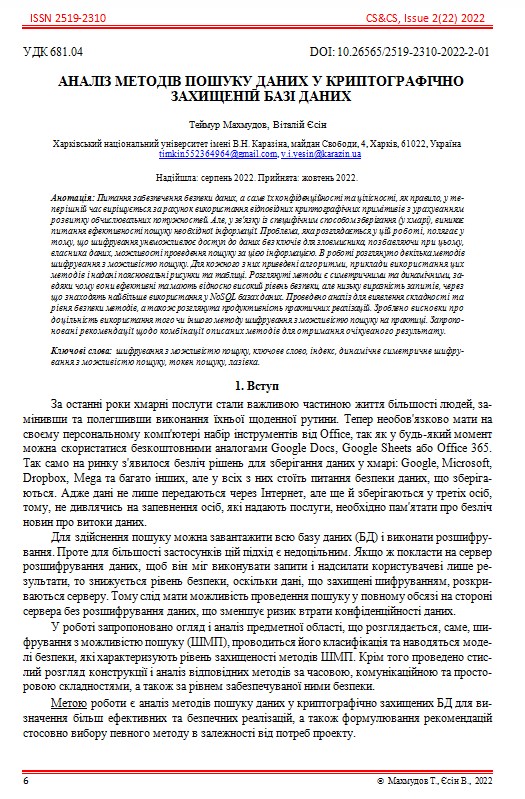Аналіз методів пошуку даних у криптографічно захищеній базі даних.
Анотація
Питання забезпечення безпеки даних, а саме їх конфіденційності та цілісності, як правило, у теперішній час вирішується за рахунок використання відповідних криптографічних примітивів з урахуванням розвитку обчислювальних потужностей. Але, у зв'язку із специфічним способом зберігання (у хмарі), виникає питання ефективності пошуку необхідної інформації. Проблема, яка розглядається у цій роботі, полягає у тому, що шифрування унеможливлює доступ до даних без ключів для зловмисника, позбавляючи при цьому, власника даних, можливості проведення пошуку за цією інформацією. В роботі розглянуто декілька методів шифрування з можливістю пошуку. Для кожного з них приведені алгоритми, приклади використання цих методів і надані пояснювальні рисунки та таблиці. Розглянуті методи є симетричними та динамічними, завдяки чому вони ефективні та мають відносно високий рівень безпеки, але низьку виразність запитів, через що знаходять найбільше використання у NoSQL базах даних. Проведено аналіз для виявлення складності та рівня безпеки методів, а також розглянута продуктивність практичних реалізацій. Зроблено висновки про доцільність використання того чи іншого методу шифрування з можливістю пошуку на практиці. Запропоновані рекомендації щодо комбінації описаних методів для отримання очікуваного результату.
Завантаження
Посилання
Paverd, A., Martin, A., & Brown, I. (2014). Modelling and automatically analysing privacy properties for honest-but-curious adversaries. Tech. Rep.
Stefanov, E., Papamanthou, C., & Shi, E. (2013). Practical dynamic searchable encryption with small leakage. Cryptology ePrint Archive.
Bost, R., Minaud, B., & Ohrimenko, O. (2017, October). Forward and backward private searchable encryption from constrained cryptographic primitives. In Proceedings of the 2017 ACM SIGSAC Conference on Computer and Communications Security (pp. 1465-1482).
Liu, C., Zhu, L., Wang, M., & Tan, Y. A. (2014). Search pattern leakage in searchable encryption: Attacks and new construction. Information Sciences, 265, 176-188.
Islam, M. S., Kuzu, M., & Kantarcioglu, M. (2012, February). Access pattern disclosure on searchable encryption: ramification, attack and mitigation. In Ndss (Vol. 20, p. 12).
Curtmola, R., Garay, J., Kamara, S., & Ostrovsky, R. (2006, October). Searchable symmetric encryption: improved definitions and efficient constructions. In Proceedings of the 13th ACM conference on Computer and communications security (pp. 79-88).
Boneh, D., Crescenzo, G. D., Ostrovsky, R., & Persiano, G. (2004, May). Public key encryption with keyword search. In International conference on the theory and applications of cryptographic techniques (pp. 506-522). Springer, Berlin, Heidelberg.
Bösch, C., Hartel, P., Jonker, W., & Peter, A. (2014). A survey of provably secure searchable encryption. ACM Computing Surveys (CSUR), 47(2), 1-51.
Kamara, S., & Papamanthou, C. (2013, April). Parallel and dynamic searchable symmetric encryption. In International conference on financial cryptography and data security (pp. 258-274). Springer, Berlin, Heidelberg.
Cash, D., Jaeger, J., Jarecki, S., Jutla, C., Krawczyk, H., Roşu, M. C., & Steiner, M. (2014). Dynamic searchable encryption in very-large databases: Data structures and implementation. Cryptology ePrint Archive.
Kamara, S., & Moataz, T. (2017, April). Boolean searchable symmetric encryption with worst-case sub-linear complexity. In Annual International Conference on the Theory and Applications of Cryptographic Techniques (pp. 94-124). Springer, Cham.
Bloom, B. H. (1970). Space/time trade-offs in hash coding with allowable errors. Communications of the ACM, 13(7), 422-426.
Bellare, M., Boldyreva, A., Knudsen, L., & Namprempre, C. (2001, August). Online ciphers and the hash-CBC construction. In Annual International Cryptology Conference (pp. 292-309). Springer, Berlin, Heidelberg.
Bost, R. (2016, October). ∑ oφoς: Forward secure searchable encryption. In Proceedings of the 2016 ACM SIGSAC Conference on Computer and Communications Security (pp. 1143-1154).
Bost, R., Minaud, B., & Ohrimenko, O. (2017, October). Forward and backward private searchable encryption from constrained cryptographic primitives. In Proceedings of the 2017 ACM SIGSAC Conference on Computer and Communications Security (pp. 1465-1482).
Boneh, D., & Waters, B. (2013, December). Constrained pseudorandom functions and their applications. In International conference on the theory and application of cryptology and information security (pp. 280-300). Springer, Berlin, Heidelberg.
Kiayias, A., Papadopoulos, S., Triandopoulos, N., & Zacharias, T. (2013, November). Delegatable pseudorandom functions and applications. In Proceedings of the 2013 ACM SIGSAC conference on Computer & communications security (pp. 669-684).
Goldreich, O., Goldwasser, S., & Micali, S. (1986). How to construct random functions. Journal of the ACM (JACM), 33(4), 792-807.


